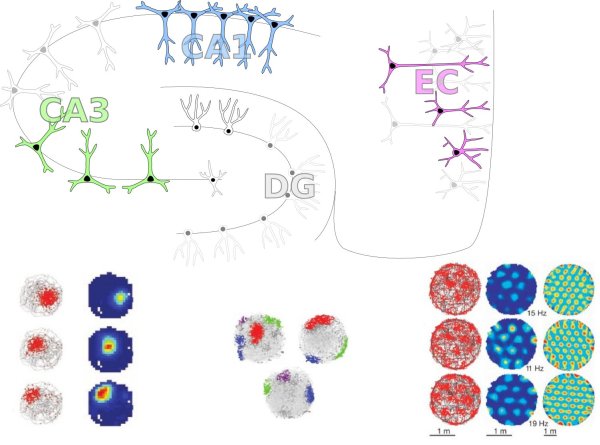Hippocampal coding and dynamics

How does the brain process, represent and store information relevant for making fast and reliable decisions supporting adaptive behavior in different animals? These are arguably the core questions in the field of neuroscience especially in computational neuroscience. The hippocampus is among the most intensively studied areas of the mammalian brain. Its relatively simple synaptic organization is well-conserved through the mammalian evolution, and its involvement in cognitive processes such as episodic memory or navigation makes the hippocampus an ideal candidate for studying neural information processing.
The physical location of an animal is an abstract and hidden variable for them as they have to infer it based on their previous sequence of movements and the currently available set of sensory inputs. How the neural representation of the allocentric space changes in the hippocampus after environmental manipulations? Can we understand spatial representations at different stages of the hippocampal processing from simple, normative principles?
Animals experience the continuous change of their environment on different time scales. Does the neural representation in the hippocampus reflect this continuous flow of information or the brain extracts discrete episodes in space, time and action? How does the time scale of the relevant neural computation interact with the time scale of the neural implementation? What is the origin of hippocampal oscillations and what is their role in processing the incoming input?
People working on this project
Zoltán Somogyvári, Balázs Ujfalussy
Publications related to this project
B. Ujfalussy, T Kiss, P. Érdi: Parallel Computational Subunits in Dentate Granule Cells Generate Multiple Place Fields PLoS Comput Biol (2009) 5(9):e1000500.
Zsófia Huhn, Zoltán Somogyvári, Tamás Kiss, Péter Érdi: Distance Coding Strategies based on the Entorhinal Grid Cell System Neural Networks 22(5-6) (2009) 536-543
D. Samu, P. Erős, B. Ujfalussy, T Kiss: Robust path integration in the entorhinal grid cell system with hippocampal feed-back. Biological Cybernetics 101(1) (2009) 19-34
Ujfalussy B, Kiss T, Orbán G, WE Hoffmann, Érdi P, Hajós M: Pharmacological and Computational Analysis of alpha-subunit Preferential GABAA Positive Allosteric Modulators on the Rat Septo-Hippocampal Activity. Neuropharmacology 52(3) (2007) 733-743
Ujfalussy B and Kiss T: How do glutamatergic and GABAergic cells contribute to synchronization in the medial septum? Journal of Computational Neuroscience 21(3) (2006) 343-357
Orbán G, Kiss T and Érdi P.: Intrinsic and synaptic mechanisms determining the timing of neuron population activity during hippocampal theta oscillation. Journal of Neurophysiology 96(6) (2006) 2889-2904
